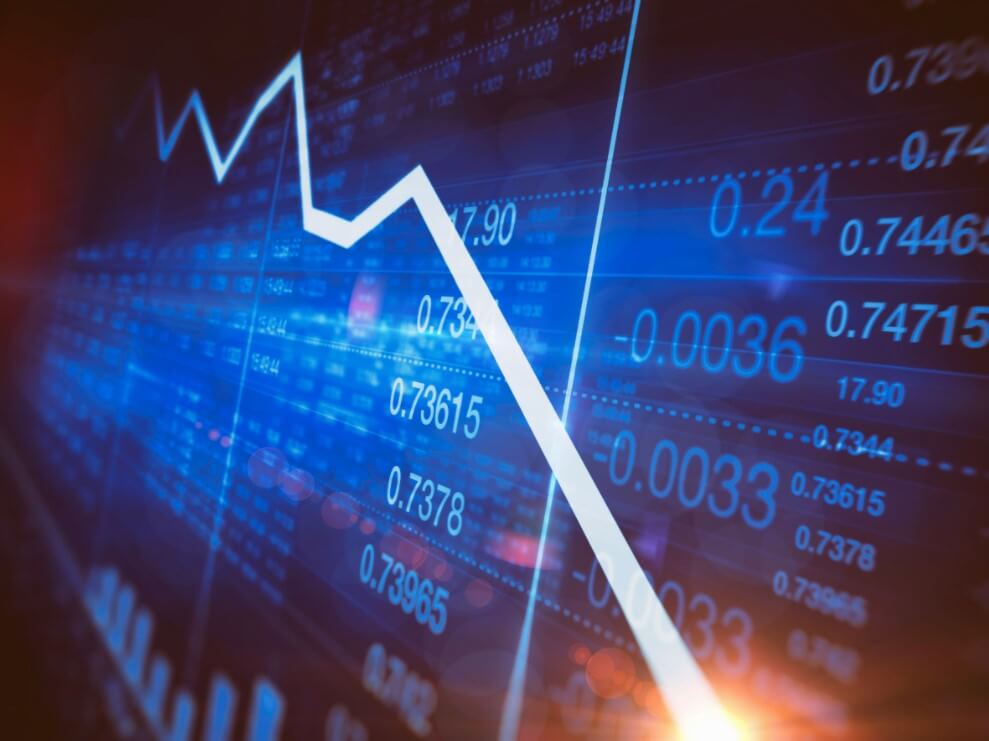Averaging down or down-averaging is a term that describes the process of buying additional amounts of shares of an asset or financial instrument (such as Forex or commodities) at prices lower than the original purchase price. This reduces the average price paid by the investor for all of their purchased assets. Therefore, it is a strategy used to reduce the average cost in a market that has fallen in price. Is averaging down a good strategy or just another way to lose money in the market?
The answer depends on several factors. First, let’s describe how it works. You buy 10,000 shares at $100 per share, but these shares fall to $92 per share. You then buy another 1000 shares at $92 per share, which reduces his average price to $96 per share. It is true that this is a simplistic example, but we will describe the concept in more detail later.
Although it may seem to make sense, and actually sometimes works, it presents a great deal of risk. The price has to go up after the averaging is done. How many times have we acquired a stock that started to go down, invested more money after it went down, and continued to put more and more money in with the hope that the price will go up? Eventually, the point comes when we surrender and throw in the towel, shortly before the stock starts to recover. This is a very common scenario and it causes the ruin of many traders.
Description of Averaging Down Strategy
Although averaging downwards offers the appearance of a strategy, it is more a state of mind than a legitimate investment strategy. In theory, if an investor likes a stock at $35 per share, and the share price drops, but the investor still finds the stock attractive at 35, then buying more shares at a lower price offers the appearance of a discount. While there may be an unrecognized intrinsic value, buying additional shares simply to reduce the average investment cost is not a good reason to buy a share or other asset in the market as its price drops.
Averaging down allows investors to reduce their cost base in a given market position, which can work well if the market starts to rise as it allows the operator to acquire more assets at a lower price and increase its future profits. However, if the market continues to fall, capital losses will only increase further. Proponents of this technique see averaging down as a cost-effective approach to wealth accumulation; opponents see it as a recipe for disaster. In leveraged products like Forex and CFD, this practice can lead to large losses in a short time.
The strategy is often favoured by investors who have a long-term investment horizon and a counter-investment approach, that is to say, contrary to market consensus. An opposite approach refers to an investment style that is against, or contrary to, the prevailing investment trend. Here again, averaging can be a general rule: buy when there’s blood on the streets.
Interestingly, over the years, some of the world’s smartest investors, including Warren Buffett, have successfully used the averaging down strategy over the years. What also gives the illusion that this technique is an investment strategy. However, investors like Buffet can buy additional shares of a company because they feel that the shares are undervalued, not because they want to «lower the average». In addition, they have large capital resources that allow them to withstand a market downturn lasting months or years.
Is that a great strategy or not? If we average in a market that’s down and suddenly the price starts to rise strongly, then we’ll say what we did was a great strategy. However, if the market continues to fall, we must make the decision to keep averaging down or close positions to limit losses. At this point, much depends on the analysis of the market in which we are operating. If we are applying averaging down to fight price stubbornly in a market whose fundamentals clearly indicate that it will continue to fall, it is simply a gamble and a sure recipe to disaster.
On the contrary, if we have conducted a thorough analysis of the market and this study tells us that there is a likelihood that the price will start to rise, the downward averaging may make sense as long as we apply it sensibly following monetary management rules. In any case, we must always have a limit of losses as the market can be unpredictable and it is always good to have a safety net.
Stock Example
To show the difference between applying averaging down without a solid foundation and using this strategy based on more logical analysis and methodology. Let’s use it as an example of the difference between investing in a stock and investing in the company behind the stock.
If we are investing in an action, taking into account only the action of the price, we look for signs of purchase and sale based on a series of indicators. The goal is to earn money in the short and medium-term and there is no real interest in the underlying company beyond how its action might be affected by the market, news, or economic changes.
In most cases, much is unknown about the underlying company to determine whether a price drop it’s temporary or we’re talking about a big problem. The best thing to do when investing in shares under this approach (as opposed to investing in a company) is to reduce losses by no more than 7%. When stocks fall to this point, positions are closed and new opportunities are expected.
Invest In a Company
If you are buying stocks from a company (as opposed to a share), the investor has carefully researched and knows what is happening within the company and its industry. You need to know if a drop in stock price is temporary or a sign of trouble.
If you really believe in the company, averaging down can make sense if you want to increase your holdings in the company. Accumulating more shares at a lower price makes sense if you plan to hold them for an extended period.
This is not a strategy that should be used lightly. If there is a large volume of sales against the company, the investor may want to ask if they know something he does not know. These investors, who are making massive sales, are almost certainly mutual funds and institutional investors. Swimming upstream can sometimes be profitable, but it can also cause an account to be lost in a short time.
Averaging Down in Other Markets
Any market this strategy should be employed very carefully or avoided altogether if the trader does not know what it does, especially in leveraged markets like Forex or CFDs where profits and losses are magnified. In fact, this is how many traders lose their accounts. They continue to buy in heavily bearish markets in the hope that the price will rise to the extent that the losses that have accumulated are such that the inevitable ‘margin call’ arrives.
Many traders, especially beginners, have the tendency to «fight» against the market and when it starts to move against, do not bother to investigate because the market behaves in this way and simply start to open up positions contrary to the trend. In a market like Forex, where trends can be very strong, these traders end up losing big sums in a short time.
For example, a change in the interest rate policies of a major central bank such as the Fed or the BoE, are capable of shaking the market strongly and changing long-term trends. A trader who stubbornly trades against these moves and continues to add positions is only committing suicide.
Very different is when a trader adds more positions in a market whose fundamentals favor him and where the price is against him temporarily, more for technical factors than anything else. For example, it may happen that a currency pair is in bullish trend and the trader bought during a bearish correction that spread more than expected. In this case, the trader can average, to a certain extent, since he knows that the price has high chances of going back up. As we see, much depends on how the trader applies the strategy.
Who Should Apply Averaging Down?
The following table shows which types of investors can apply the averaging, and how to reduce the risk in case the market continues to fall. Here are some definitions of the main types of strategies.
Buy and Hold: It is a strategy where a person or company invests in an asset, such as an action, often for years. They are not interested in speculating on the purchased assets and their short-term movements, as they expect them to have an increase in long-term value that they can take advantage of.
Position Trading: A position trader is willing to invest in a market for months and even years until the signs of a major change in trend become evident.
Swing Trading: Swing trading operators try to take advantage of the trend movements of the market by trying to enter near the trend lows or trend highs, to win with the bullish and bearish price swings of the short and medium-term. The period in which operations are kept open is short, often for weeks or months.
Day Trading: A day trading operator conducts short-term trades where each position is usually closed before the end of the trading day.
Trading style, is it convenient to use averaging down?
Buy and Hold
Yeah, but be careful in a bullish market. Check your investments to make sure the fundamentals are still in good shape and that the technical aspects are attractive. Fibonacci setbacks work well in these circumstances. Measure the previous price increase from the minimum to the maximum of the movement and if you want to apply averaging down make the additional purchase around the Fibonacci retracement of 61.8% of the previous bullish movement. In a bearish market, then it’s best to wait. Otherwise, it’s like catching a falling knife. It can be a pretty dangerous process. Why risk it? Wait for markets to appear.
Position Trading
Yes, but it must hold the positions long enough for the market to recover and it must only be used in a market with the right conditions, that is to say in a bullish market. Ensure that the sector is also growing and that the fundamentals favour it so that any downturn in the market is due to short-term factors (as in the case of a stock with a bad quarter in a company with promising projections for the next quarter).
Swing Trading
Probably not. If we go in too early, expecting a change in trend and the price continues to fall, we can average down if the market and the industry are going up, but we do this only once. If we are tempted to average a second time, it is best to close the losing position and accept the loss. Remember, you are supposed to be a professional. Admit your mistake, take the loss, and continue.
Day Trading
No. As a day trading trader, the trader must leave before the end of the day and we have no guarantee that the price will be recovered at closing. A day trading operation should never be allowed to become a multi-day position. It is common for a trader to quickly lose their funds that way.


